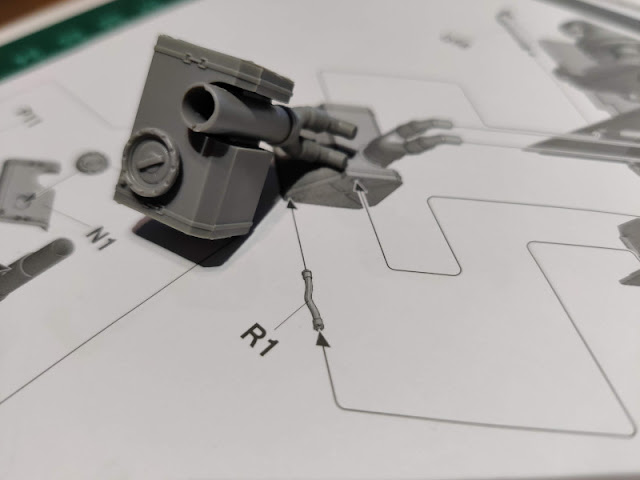A model in a model
Naturally the steely kitty had to have something inside to make it purr. This purrificator was like its own model, it was such a detailed and complex thing on its own. Before I started this project I had taken a look at what people had said about the kit, the engine was often mentioned on its own. Based on what I had read, I had decided to build and paint it separately, way before installing it inside the tank.
Central block
As usual, I had no proper understanding about motors or their specifics. The build began with that large block, that I knew to contain some cylinders, pistons and a crankshaft. So far so good, very clear stuff: attach these and trudge onward.
More little stuff almost flew onto the motor piece. From its front end (or rear end?) it apparently got attached to the tank's floor with some pretty simple-looking paws. At least they looked not-too-sturdy, but in this house we have always trusted in engineers.
This whoknowswhatsit that lived on top of the main block looked like a hidden face, a gas mask - wearing cartoon. In real life I guessed it had more to do with the valves and such would've lived, had this one not been a V12-engine. My next guess for this was that these also had something to do with mechanical timers or something. Interweb sources pointed towards a magneto, so that and some stuff related to air filtering most likely.
First V
To the end of the rightmost hand of the V was some kind of a container, that seemed to have some motor oil refilling caps and such, based on the look. With these little pipes the confusing and bothersome thing was that their installation angles weren't too clear to me.
Damn cool details, but was anyone going to see any of these when the installation was done? Most doubtful.
That was the first half of the upper end of the V-motor. I found the angle of the main piece a bit suspicious, but there was no clear sign of how it was exactly supposed to be, and the studs didn't give much if any haptic feedback again.
This next piece had presumably something to do with the exhaust system, being a large-diameter pipe attaching to the base of the motor. Unless that was something as odd as all of the exhaust piping that resided inside the tank, and it did look like that.
Second V
Being asymmetric the motor's second upper corner wasn't much quicker than the first one. Here a sickening amount of all kinds of weird lumps, ducts, pipes and narrower pipes were glued to live next to each other. Everything had to be set in place based on fancy 3d drawings and how the next step looked like in the instructions (or in the painting guide), and also by gut feeling. Personally I'd really appreciated clearer images and/or pieces that didn't make you guess if they were properly aligned.
The second exhaust pipe was funnily different from its sibling. With them installed even I started to figure out, which way it was supposed to be facing.
Below the exhaust pipe a bunch of interesting pieces found their homes. It'd been pretty neat to know what they were instead of having to ddg from
who knows where. Any cylindrical bits were for moving liquids around, that much I could guess, but separating what was related to water and what to oil, that my eyes could not tell me.
A readyish motor
After it had eaten a few evenings worth of tinkering time it was about done, as soon as the air filter's box was glued on. At this point only I could tell that the V angle was not correct but a bit too wide. Of course this piece of engineering was still missing some pipes, ducts and pumps, but those could not have been installed yet, because the motor wasn't in its place.
Behind its tank
While the last gluings were still curing I didn't even dream of smashing my motor inside its cubicle, but left it just behind the tank to pose a bit. Unbelievable, but true: it was indeed going to eat all that space and maybe even more. An astonishing monster of a motor.









































